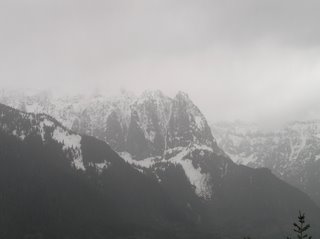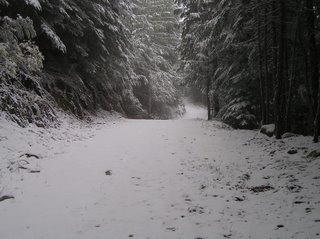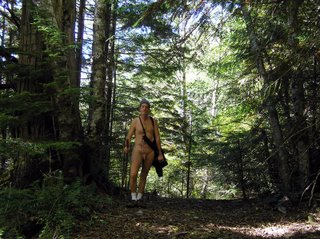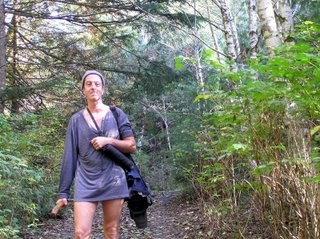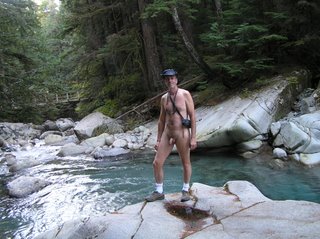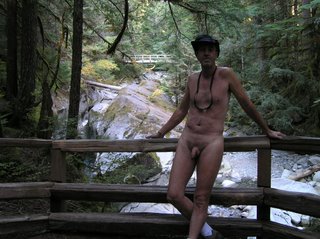I must apologize to my readers for being so remiss about updating my nude hiking blog. First work, then a deeper involvement with both Scenic Hot Springs and then Olympic Hot Springs . . . and then I caught the flu bug, which knocked me out for two weeks.
But the silver-lining is that I've been doing an awful lot of hiking in the past several weeks since my last hike-connected post . . . sometimes as many as four or five hikes a week because I could take advantage of location and opportune timing. How could I pass up a chance to hike rather than stick myself in front of a computer to write up a hike? In most cases, these hikes have been to places I've hiked and written about before . . . but there are a number of gems I've discovered that deserve to be shared with you. Two of these are the subject of today's post:
- A revisit to Sunset Mine and a quaintly, serene and obscure side trail up Trout Creek, and
- An exploration of the upper river plain of the North Fork of the Skykomish River between FS65 and Pass Creek.
Cold Weather Nude Hiking PrecautionsThe 'academic' subject of today's post is getting 'ready for cold-weather nude hikes'. I've been doing a number of cold-weather acclimatization hikes the past week as the weather has changed . . . mainly night hikes to get myself used to the cooler temperatures of autumn and winter in the mountains. The advent of heavy overcast and rain was just too good an opportunity to past up. On Saturday I hiked the Sunset Mine area and the following day hiked the flood plain of the upper North Fork of the Skykomish River under some heavy downpours, at times. What better opportunity to acclimize my body to cold! Afterall, snow is just around the corner and I love to hike naked in the snow!
The Sunset Mine route is via a small and abandoned mining road just after the Trout Creek bridge on the Index-Galena Road. The mining road switchbacks up the mountainside for about a mile and a half. It is pretty-torn up and eroded beyond the initial approach . . . something only a good 4-wheel drive would consider, and personally I would reconsider trying. Though I saw reasonably fresh tire tracks on my way up I reasoned they must have been from the previous day. I couldn't imagine anyone would be out here in this kind of weather (not everybody is a crazy as I am). I was wrong.
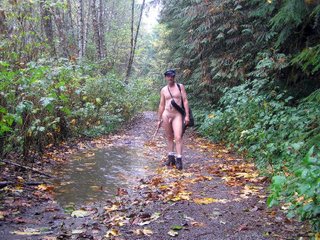 The beginning of the old Sunset Mine road and
The beginning of the old Sunset Mine road and
getting used to the rain on my bare skinThe hardest part about hiking nude in autumn rains is getting out of the car and just hiking. The rain is just plain COLD!!! But I prepare myself appropriately. I am not doing this because I get some sort of perverse pleasure out of shivering . . . I am trying to get my metabolism operating more efficiently. I carry appropriate clothing and rain gear should I bite of more than I can deal with. I also carry a thermos of hot cocoa as an efficient way to warm my insides up . . . and I know the warning signs and my limits.
So we're going to take a little diversion before I continue sharing my two hikes. I think it only appropriate for a review of the body's response to cold and the adverse effect of excess exposure to the cold . . . or hypothermia . . . as it relates to nude hiking. Hypothermia is defined as the situation where the our core body temperature drops below a certain point that metabolic processes become impaired. We are warm-blooded creatures and our celluar processes can only take place within a narrowly-defined range of temperatures.
Hyperthermia is where that temperature range is exceeded (heat exhaustion and heat stroke).
Hypothermia happens when our core body temperature drops below the normal range (technically, when our core body temperatures drops below 95F). Our normal response to cold is to shiver. Shivering involves involuntary contraction of our muscles to produce heat and warm us up. Shivering is our first sign that we may have dropped our core body temperature too far.
- Clothing does not warm us. All the warmth we feel when we are bundled up is the result of our metabolic processes. Clothing does not increase that warmth or add warmth to us. Clothing only adds various layers of insulation to slow down the escape of heat from our body. In fact, wet clothing can actually suck the heat from our body faster than being nude in cold weather. There is a saying in outdoors circles . . . 'Cotton Kills'. Cotton is the worst material you can wear in cold weather if there is a chance you might get wet. Water pulls heat away from your body with fifty times the efficiency of dry air!
- Acclimization involves slowly introducing yourself to cold temperatures over time. The Inuit Eskimos have core body temperatures 3-5 degrees lower that our more-normal 98.6F. They have shifted their ability to withstand cold temperatures those few degrees lower and still maintain normal metabolic functions. So acclimization is first a shifting of that optimum core temperature range. Acclimization also involves making your metabolism more efficient so that the heat that is produced as a byproduct of metabolizing food, is increased. The other effect is a thickening of your blood so that it carries more heat. These effects can only happen by a gradual introduction to cooler temperatures.
- Nutrition plays a large effect on our body's ability to withstand cold. Eating a large meal has a typical effect on most people; we feel tired . . . that nap after dinner. Why? Digestion diverts as much as 30% of our available energy reserves to digest a meal . . . energy that is not available to keep up with body heating needs during cold weather exposure. The same mechanism is responsible for the adage about eating before swimming. Try to avoid eating a large meal within a couple of hours of cold weather exposure . . . or any strenuous exercise, for that matter.
- Food is our heating fuel and we need plenty of reserves. Some foods are better than others. Marathon runners carbohydrate-load themselves at spaghetti feeds the night before a run. Sugars and carbohydrates are easily digested and provide a good energy source, but deplete rapidly. Sugars are akin to gasoline in their readiness to burn, whereas carbohydrates more closely resemble diesel fuel. Proteins take a lot more of our digestive system to convert to an energy source but burn hotter once in the cell and in a usable form. Fats are the ideal energy source for heat production as they burn slow and steady. Cold weather enthusiasts swear by the value of a few squares of chocolate to keep them warm in the coldest of weather. The verdict is out on the ideal diet for cold weather. I carbohydrate load the night before and carry a couple of 'runner's gel' packs and a bar of good chocolate on my hikes. It seems to work for me.
- Part of acclimization is increasing the efficiency of our metabolism . . . so that we produce more heat out of the food we eat. Just being exposed to cooler weather will boost our efficiency slightly. Exercise also increases the efficiency of our metabolism. There is a lot of evidence that vitamin B6 increases the rate of metabolism.
So cold acclimization is the process of getting our body to produce more heat to deal with loss of body heat to the environment. Acclimate yourself appropriately and you can hike naked in air temperatures of 45-50F forever without suffering the ill effects of hypothermia . . . that is, until you quit the strenuous effort of hiking or run out of energy reserves. You can withstand the effects of colder temperatures down to, and below, freezing for a limited time with appropriate protective measures (head covering, gloves, boots). So what happens when our body is exposed to cold weather and starts to lose heat faster than it can produce it?
- Major Heat Losses: Stop the most egregious heat losses. We lose 60% of our body heat from our heads. Wear a hat! Wear good boots and thermal socks. Conductive heat loss is magnitudes more than convective heat loss. Protect your feet . . . after all, they are your motive power back to safety. If it is very cold (less than 40F) or raining below 50F, consider gloves to protect your fingers, and perhaps protection for that other extremity.
- Other Heat Losses:
- Avoid diuretics like coffee. They cause more frequent urination and a major loss of body heat.
- If necessary, take a decongestant like Sudafed to keep your sinuses clear. Breathing through your nostrils prewarms the air going into your lungs, and vice-versa, extracts heat going out in exhaled air. Breathing through the mouth because of stuffed up sinuses simply introduces cold air right into the core of your body.
- Moisturize your skin to seal the pores and help to shed moisture. If you can keep the surface of your skin sealed and dry you remove a major avenue of heat loss due to evaporative cooling.
- DO NOT HIKE NUDE in subzero temperatures for more than a few minutes without having a 'safe haven' nearby. The danger of frostbite is very real, particularly to the extremities and male appendages. Despite advice otherwise, you cannot get frostbite when the ambient air temperature is above freezing, no matter what the wind chill factor is . . . even if you are wet. Wind chill is nothing more than the subjective impression of the temperature. The wind can cool no more than the temperature of the air, itself. However, don't be foolish to keep hiking nude in cold weather when the wind picks up. Hiking in still air builds up a very thin warmed layer of air next to your skin that insulates you somewhat . . . particularly if you have body hair to help trap that insulating layer. Wind strips this layer away in a process called convection. Convective cooling can quickly drop your core body temperature to dangerous, and fatal, levels. By aware of how your body is reacting.
- Shivering is the first response. If you've just got out of a warm car and stripped down, shivering is a reasonable response to the sudden cold. Start hiking and if the shivering goes away in a few minutes then you are now producing enough heat to make up for the loss. If not, then it is just too cold. Respect continuing shivering for what it means . . . you're steadily losing heat.
- The nipples respond by hardening, often painfully. It's a normal response to the cold. Goosebumps and a general tightening of the skin indicate that your body has constricted blood flow to the outer layers of the skin to conserve heat. In dry temperatures between 45-50F that's as far as the symptoms go if you are hiking strenuously, thus producing heat to keep the core body temperature within the normal range.
- Stage One Hypothermia: If the temperature goes down, starts to rain or snow, or you slow down or stop to take a break, then you are probably going to lose heat faster than you can produce it. Your body gets more aggressive about conserving vital core body heat. It increasingly constricts blood flow to the extremities, including the male appendages . . . in effect, sacrificing them as non-essential to survival. Unfortunately, we need our legs to get to safety. The warning signs that this is happening are the cramps we start to feel in the larger muscle groups of the buttocks and thighs. Those muscles are no longer receiving enough oxygen and nutrients via blood to sustain activity. Lactic acid builds up . . . the familiar runner's cramp. Fingers may cramp painfully as to be useless. At this point, you are in Stage One hypothermia. This stage sneaks up on you slowly so pay attention to large muscle cramps. You have this last chance to get yourself covered up to stop further heat loss and recover.
- Stage Two Hypothermia: Convulsive and explosive shivering is your warning sign that you can no longer produce enough heat to make up for what is being lost. Your core body temperature is dropping below 95F and you are in danger of entering Stage Two Hypothermia. This shivering is triggered by the hypothamus in the brain as it detects a dangerous lowering of the core body temperature. This is not the mild discomfort of shivering when you feel a chill. This is your whole body spasming violently by contracting muscles to produce heat. The energy to produce this hard shivering disirients you and quickly uses up any energy reserves you may have had. As these ready-reserves are used up the shivering can not be sustained and you may be lulled into thinking you're okay. You're not; the shivering failed and now you are losing heat at a quicker rate than before. Clothing up now will be insufficient, if you even think about it in your disoriented state.
- Shunting: High in the arms and thighs are arteial shunts between the major arteries and veins. They are now opened to redirect warm blood back into the core to keep what warmth you still have supplying the core organs (the heart, lungs and brain). The extremities are now totally sacrificed and receive no more warming blood. You become incapacitated and lay down, eventually slipping into cold-induced coma. Professional medical intervention is needed to recover from this stage. In the wild, rapid rewarming with careful attention to not moving the victim too roughly; direct nude body to body contact in a sleeping bag, Naglene containers of warm water against the major arteries in the groin and armpits . . . are some measures that can be taken. One major danger is the jostling of stage two victims that might relax the arterial shunts and suddenly release freezing cold blood from the extremities to the core. Rescue personnel favor a respirator with humid, heated air to re-warm a hypothermic person. Of course, this all assumes that you are hiking with someone who can watch for symptoms and take action, if necessary.
- The Effect of Body Fat on Cold Weather Nude Hiking: Fat is a great insulator against the cold, as anyone who has seen the blubber layers of whales and other sea mammals knows. On the face of it, when someone tells me that because women have a greater proportion of fat then men . . . or a man tells me he can withstand the cold better because he has a good layer of fat, it seems to make sense. That layer of fat insulates you much in the same way clothes insulate. On the face of it, these statements seem to make sense and the insulating function is true . . . until you enter stage two, or deep hypothermia. Subcutaneous fat (that under the skin) is a two-edged sword when dealing with hypothermia.
Remember, insulation works two ways . . . it can keep the heat in but conversely, when you need external heat, a layer of fat can keep that life-saving heat out! Last winter I did a severe nude snow hike under a mixture of icy rain and snow. By the time I got back to the safety of my car, I believe, in retrospect, that I was close to entering severe hypothermia. Another few minutes out in exposure and the severe shivering would have started. Already my arms and legs were severely cramped. Inside the car the heater went on full and I toweled off. I stayed nude knowing that my body would suck in the heat from the heater vents far more efficiently than if I had an insulating layer of dry clothing in the way. Coupled with plenty of hot chocolate to warm me from the inside, I recovered reasonably fast . . . reactivating the shiver-response as a good sign that I was boosting my core temperature.
I have little body fat because of the hiking I do. But there is one place where we all have a layer of subcutaneous fat (called adipose) . . . and that is overlaying the stomach or abs. We all fight to get rid of it but it's always there, sometimes a lot, sometimes not depending on your physical conditioning. Fat is poorly served by the circulatory system which aids it's insulating qualities. The problem with fat is that once it becomes cold, it tends to remain cold for a very long time . . . and in the process, subverting your attempts to re-warm yourself. Fat becomes both a cold-sink to suck core heat out of you from the inside, and also to insulate against external heat that you want to seep into you to re-warm your body. Three hours after that hike, while the rest of my body was comfortably warmed up, the half-inch layer of fat covering my abdomen was still icy-cold from the hike! So fat is a two-edged sword. It can be your friend on a short excursion into the cold but turn tables on you after severe cold exposure by becoming a reservoir of cold right in your body. Personally, I keep my body fat down as much as possible and rely on my ability to generate the heat I need to replace that lost.
So . . . have I scared everyone off from hiking nude in cold weather. I hope not. Armed with how you body reacts and taking precautions (like carrying clothing), nude hiking in inclement weather can be one of the most enjoyable things you can do. The skin is your largest sensory organ and be it bright sunny weather, rain drops tickling your skin, or snow flakes swirling around your nudity . . . the experience is unlike anything else. And your likely to have the trail all to yourself! Just make sure someone knows where you are going and when your expect to be back.
Sunset Mine Road and a new Trout Creek TrailWe took this diversion because I believe it is important. But the weather isn't that bad yet and the last time, I believe I was hiking up the mile and a half mining road to the long abandoned Sunset Mine site . . . and wondering about the tire tracks on the very torn up road.
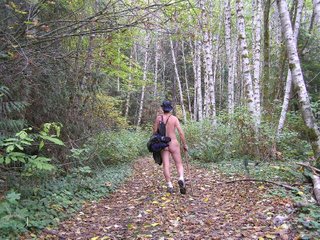 The last stand of alders just before coming onto the clearing
The last stand of alders just before coming onto the clearing
where the concrete foundation of the old mill site still stands.I ambled quite slowly, enjoying the drizzle amid the autumn scenery. The old road does a lot of climbing before leveling out near the mine site. Every once in a while I'm attacked by a falling leaf to add to the thick, muffling carpet already covering the road. Then I hear the shot in the near distance, followed by four more rapid fire rifle reports. Close, just around the final bend that I stop abruptly. The calm and quiet is shattered. I step forward cautiously and see the beat-up red Ranger blocking the beginning of the mill clearing up ahead. I see no shooters but that is just as well for I have no desire to walk in naked amongst a bunch of yahoos shooting up the concrete of the old mill site. I turn and back off slowly. Behind me more volleys of high-powered rifle rounds rebound and echo through the tight valley. It's a bloody war zone back there! Exploring the mine site is not in order today. An hour later I'm back at my car, standing there naked and wondering what to do.
I feel cheated and still in need of nude time. In years past (before the current Index-Galena Road was graded), this mining road curved back in to cross Trout Creek a few hundred yards east of the present bridge. I head off down that overgrown trail.
 The burned out remains of a squatter's
The burned out remains of a squatter's
Airstream trailer; now an eyesore.
The road only goes down a few hundred feet before ending in a large turnabout before Trout Creek. It's a party location . . . a site unseen from the highway where the irresponsible can build large fires and drink beer all night. The area is trashed with bottles and cans, the half-burned cartons of half-racks and styrofoam food containers. A ugly mess.
Toward the back of the clearing are the remains of a small Airstream-style trailer that burned to the ground a long time ago. Evidence of the old mining road continues down to the creek where all that remains of the old crossing are the concrete remains of the bridge abutments. None of this shows on any topo maps and one wonders where, on the other side of the creek, the ancient overgrown roadbed of this mining road went. An exploration for a future hiking trip?
A deadend. The creek is too active to ford or cross and I'm not much for standing around simply admiring the scenery for long. I like to be moving. I almost turned around to give up on hiking for the day. A few miles further up the Index-Galena Road is the Troublesome Creek Campgrounds which, though closed and gated during the off-season, have a very scenic nature trail and foot bridges. Short, but pretty and at this time of year all mine for a nude stroll.
Then I looked at the lay of the land and the natural bench that seemed to follow the northern side of the creek in . . . just beyond the burned-out trailer through a stand of mossed-over bramble. Stepping through I thought to myself, this is too straight and uniform in width to be natural . . . this is, or was, a very old road bed; perhaps even predating the known mining road to Sunset. I stepped into the lush, temperate rain forest canopy of an artificial bench leading up Trout Creek, mesmerized by the towering granite cliffs far above the riverside canopy. On the other side, strong and vigorous Trout Creek roiled over cascades and small waterfalls. If anyone has ever seen the towering mastifs along the Bagby Hot Springs Trail, this is what they reminded me of.

The road was old and crumbling in places to the creek . . . difficult to even tell it was once a road except for the unnatural even width and flatness of the bench. It certainly appeared to have been built to last from the huge granite rocks that formed the substrate beneath . . . now long since covered by a thick layer of humus and the decaying remains of numerous treefalls. I thought to myself that I'd discovered a new trail and began to wonder if it lead all the way up to the effluent discharge from the Sunset Mill. A decaying paper plate in the undergrowth dashed any aspirations of original discovery. Still, it was fascinating to hike, with the occasional scramble down the banks to checkup on the creek personally. Trout Creek, for it's major length, is a wide, boulder strewn creek wide open to the sky. Much to rough to ford this low down, even this late in the season.
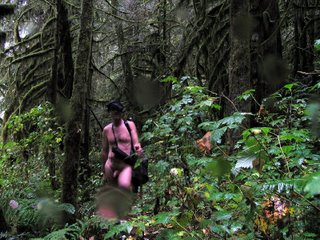
Hiking under thick canopy during a downpour is fun. The canopy keeps most of the rain off of you until it has a chance to collasce those droplets into larger behemoths that suddenly pelt you right in the face just as you're looking up. Everything is lush and verdant. The humus layer is tricky, requiring me to probe ahead with my stick to assure footing won't collapse into an eroded section. Eventually, even my fantasies about another, more scenic route to Sunset are dashed as the bench ends abruptly at an impenetrable block of granite right up against the creek bed. No obvious way around and steep terrain beyond; it's too treacherous to attempt in this weather. Maybe another time. I take my time heading back, having gone in almost 3/4 of a mile . . . halfway to the mine site.
The Floodplain of the North Forth of the Skykomish River above the FS65 Bridge toward Quartz and Pass Creeks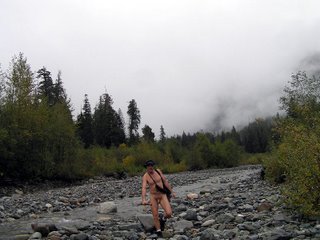 The wide, exposed floodplain of the
The wide, exposed floodplain of the
North Fork of the Skykomish RiverSunday I woke up early to the steady patter of rain on the carport outside. Saturday and Sunset Mine had not sated my need to get out there and hike naked. I lazed and stretched in bed, my skin tingling alive and itching. Coffee at the local espresso and little interest in the paper. Seattle is depressing when it's under a steady drizzle. Everything is so muted and no one seems to be around to get into an argument about politics or religion or sex. Everyone was hiding. It was a lark. I just got in the car and somehow, magically, found myself on the highway towards the mountains. The rain got worse as I climbed past Goldbar. Nary a car on the highway. I stripped in the empty parking lot of Big Eddy State Park and was soon driving nude past Index. Never had to cover myself for an approaching car. I had the roads all to myself.
And I really hadn't a clue as to where I was going. Sunset had me nervous and worried about gun-toters. The short Trout Creek Trail had hemmed me in and though I enjoyed that hike, I wanted and needed to be out in the open. It had to be this side of Jack Pass as I didn't relish the hard drive up, nor did I want to hike ridges with the thunderclouds in the area. That left either Silver Creek and possibly a visit to Mineral City, or some exploration of the wide valley above Garrand Mineral Springs where the North Fork of the Skykomish River easily babbles through after it's steep rush down from the Quartz and Pass Creek ravines. At this time of the year the river is barely thirty to forty feet across and usually no deeper than midthigh. But the river-rock debris field lay evidence to how powerful this river would become during the spring runoff. Meanwhile, that floodplain provided some wonderful hiking in wide open spaces.
Forest Service Road 65 bridges the river just north of the mineral springs, and there are several great campsites near the bridge. My favorite is the dip into a levee-protected low area on the northeast side that, given the rain, I was not going to chance getting bogged down in my Civic. I parked on the other side of the bridge in an open area right up against the river.
It was raining steadily, staccato on the car roof . . . and a hand out the window told me it was colder than yesterday. That's always the hard part for me . . . sitting there in a nice warm car and I'm crazy enough to want to step outside naked into cold rain?
The river was rising too. Not visibly, but I'd been by here a few days earlier. The river was definitely higher. Hiking a floodplain with few easy escape routes is a stupid idea. But I'm stupid. I made only one concession . . . I wore my rainjacket until I got to the other side of the FS road and back under cover. The scramble up the roadside bank and across was enough to get my adrenalin and metabolism working. The jacket got rolled and strapped to my pack. I let the pelting rain soak my body, enjoying every sensuous ping and splat. My precious floppy blue hat was soaked and sounded like my carport had earlier . . . only louder!
 The power of this river is revealed by the huge trees that
The power of this river is revealed by the huge trees that
get swept down the river from somewhere high in the mountains.During weekends at the height of summer, this floodplain is very popular with campers, and is the area that I described in an
earlier post as the beach in the mountains. There are indeed, numerous areas of deep sand bars to loll about lazily in the summer sun (and few visitors the further in you go).
About half a mile in is the first ford across a sharp bend in the river to avoid the steep east bank. The water is swift and hip deep in places. It is also exceeding cold since this fork of the river is fed from the Columbia Glacier on Monte Cristo Peak. Let's just say that by the time I reached the other side every part of me below my hips was achingly cold and threatening to fall off.
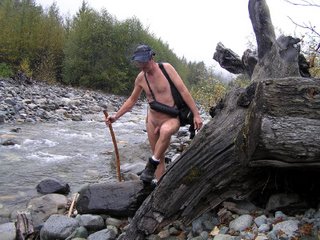 Ford? Or take my chances scrambling over slippery rocks?
Ford? Or take my chances scrambling over slippery rocks?Fortunately the rain let up to occasional drizzles and I was soon feeling comfortable once more. The river plain goes on for miles like this . . . I've only explored past five fords. Today, I don't feel like adding any more thigh-deep water crossings than necessary. I have one to recross on my way back. I spend the next hour just walking around and having fun. A light lunch and hot chocolate go a long way to warming you up. I just love being in the wide open like this. Good for the soul. Cheers!


